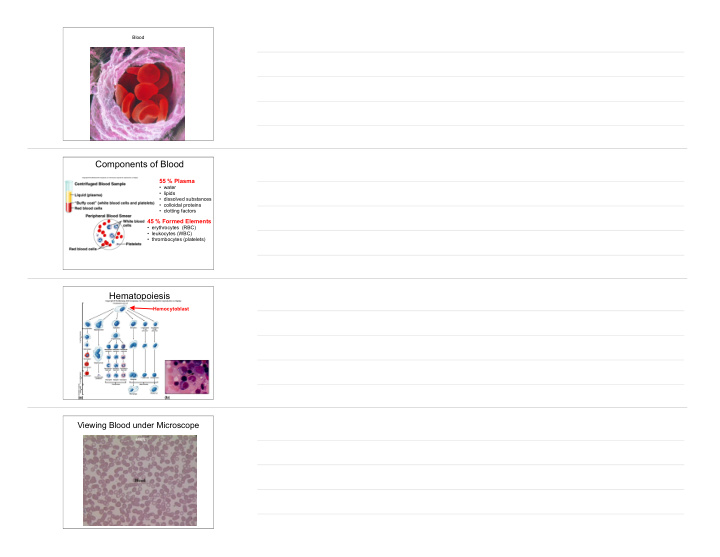



Blood Components of Blood 55 % Plasma • water • lipids • dissolved substances • colloidal proteins • clotting factors 45 % Formed Elements • erythrocytes (RBC) • leukocytes (WBC) • thrombocytes (platelets) Hematopoiesis Hemocytoblast Viewing Blood under Microscope
Erythrocytes 99% of the formed elements are Red Blood Cells (RBC) There are about 5 million RBC/mm 3 of blood Red Blood Cells are Biconcave Sunken center where the nucleus use to be White Blood Cells There are about 7000 WBC/mm 3 of blood Two types of leukocytes: granular & agranular Leukocytes Three kinds of Their cytoplasm is rich in granules granulocytes which stain typical colors that help with neutrophils their recognition. The nucleus is condensed in a little masses or lobes . eosinophils basophils Two kinds of Because these cells appear to be agranulocytes lacking in granules, they are named lymphocytes agranulocytes . They have a compact monocytes nucleus and a transparent cytoplasm
Granulocytes • Neutrophil – Make up the majority of WBCs (60 – 70%) – Nucleus with 3 – 5 lobes – Fine reddish to violet granules in cytoplasm Granulocytes • Eosinophils – Make up 2 – 4% of WBC – Nucleus has two large lobes connected by a thin strand – Large orange-pink granules in cytoplasm Granulocytes • Basophils – Make up 0.5-1% of WBC – Nucleus is U or S shaped, but typically hard to view – Dark violet granules in cytoplasm Agranulocytes • Lymphocyte – Make up 25-33% of WBC – Large round nucleus, dark violet in color – Small lymphocytes: nucleus occupies much of cell – Large lymphocytes have more cytoplasm
Agranulocytes • Monocyte – Make up 3 - 8% of WBC – Large kidney- shaped nucleus, light to dark violet in color – Abundant cytoplasm with fine granules Platelets Blood Typing • Blood typing is determined by the type of antigens or markers that are on the surface of red blood cells (either "A" , "B”, or “D”) – D and Rh antigens are the same Blood Typing No antibodies
Blood Typing ABO Blood Typing anti-A serum anti-B serum 18 Genetics & Blood Typing • The gene for 'Type A' and 'Type B' are equally dominant (i.e. Codominant), and the gene for 'Type O' is recessive. • This means that If a person is Type A, then they could have a genetic pairing of either 'AA' or 'AO' because the 'Type A' disguises the 'O' gene. (The same goes for 'Type B') • Only if the person has both genes as 'Type O' can they be classed as 'Type O' due to the lack of a dominant A or B gene. Genetics & Blood Typing • The table on the Genetic makeup Blood type right shows how AA A blood types and genetic makeup AO A correspond: BB B BO B AB AB OO O
Genetics & Blood Typing • Rh Factor : Genetic makeup Blood type Possession of the D or Rh + + Rh positive antigen is also a dominant gene. + - Rh positive Rh - - negative Questions: • Can a man who has type O blood be the father of a baby who is type AB? NO • Can a woman who is type B and a father who is type A give birth to a baby who is type O? YES Hematocrit • Hematocrit: The proportion of the blood that consists of packed red blood cells. The hematocrit is expressed as a percentage by volume. • The red cells are packed by centrifugation. • The hematocrit is normally ordered as a part of the complete blood count (CBC). • It is also repeated at regular intervals for many conditions, including: – the diagnosis of anemia and polycythemia – the monitoring of treatment for anemia, – recovery from dehydration, and – monitoring of ongoing bleeding to check its severity. Hematocrit • Normal Values – Adult males: 42-52% – Adult women: 37-48% P X 100 W W P
Recommend
More recommend